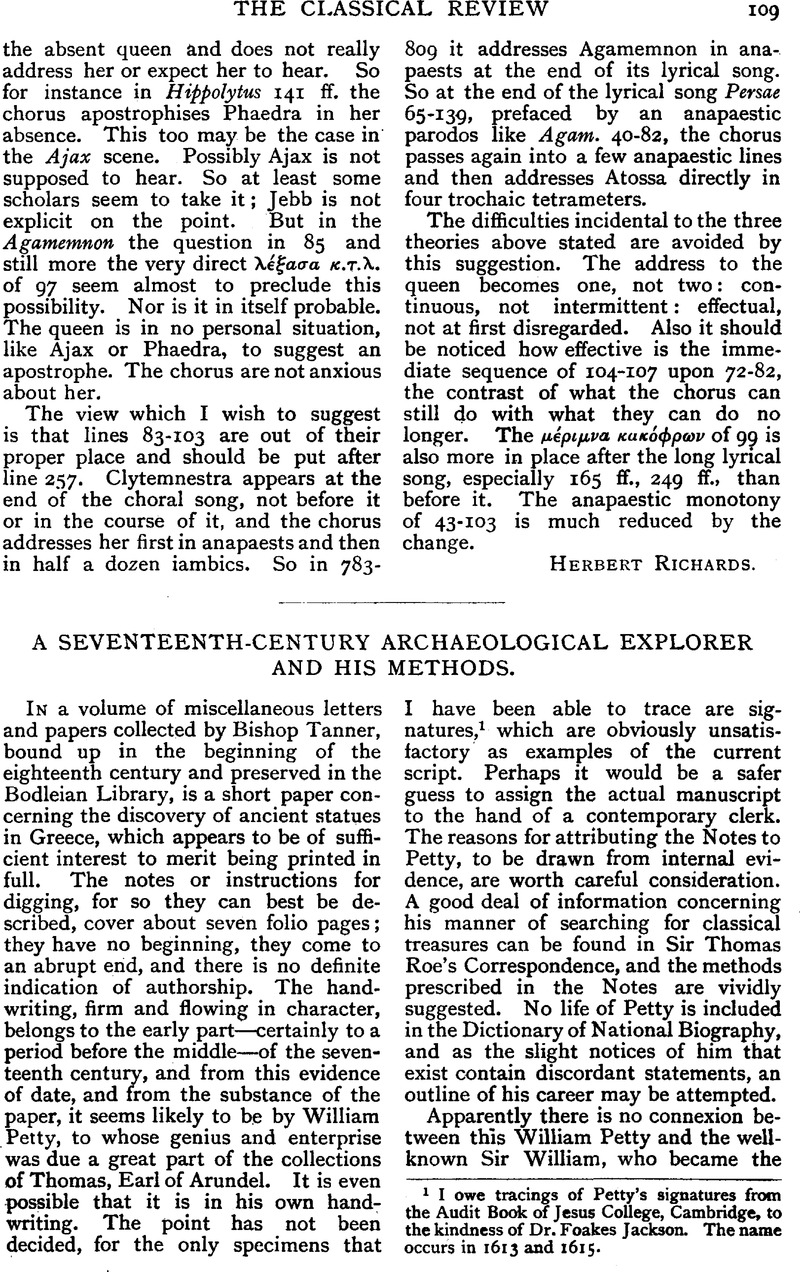No CrossRef data available.
Article contents
A Seventeenth-Century Archaeological Explorer and his Methods
Published online by Cambridge University Press: 27 October 2009
Abstract

- Type
- Original Contributions
- Information
- Copyright
- Copyright © The Classical Association 1912
References
page 109 note 1 I owe tracings of Petty's signatures from the Audit Book of Jesus College, Cambridge, the kindness of Dr. Foakes Jackson. The name occurs in 1613 and 1615.
page 110 note 1 ‘Dallaway, Walpole's Anecdotes, 293.
page 110 note 2 Lansdowne MSS. 770, and Catalogue.
page 110 note 3 The extract was kindly copied for me by Mr. Arthur Gray, of Jesus College, Cambridge, and is partly quoted in his book on the College, p. 81.
page 110 note 4 Archeologiaix. 182.
page 110 note 5 The whole passage is as follows, and may be given in full, since it has so often been used to discredit an interesting figure. It is really valuable as evidence of his high character and good influence. ‘ When I came [to Jesus College] I was admitted in the rank of those calledFellow Commoners; and there being one who three years before had been sent from Beverley School by my said tutor [Petty], he recommended him to be my companion. He was, indeed, a good scholar and a witty man, but given to drinking, and so debauched us all, so that I had been utterly undone but for an intervening occasion which, though it proved prejudicial to my scholarship and learning, by God's great mercy, conduced to reclaim me from my debauchery and drinking; which was this: My said tutor Petty was called fromCollege to London to be tutor and master to the Earl of Arundel's sonsin their father's house, and, at his departing from the College, turned over his pupils to one Mr. Slater, a Fellow of the said College. He gave me £30 in gold, saying “ though I had a tutor to read to me, I was old enough to take care of myself, and order my own money and expences; and that he would henceforward look for a good account from myself both of my money and my deportment.” Which speeches I pondered much in my thoughts upon my way back to Cambridge, concluding that my tutor was to be responsible to my father for my past actions, but myself for the future; which, I praise God, took such impression in me as from that time I quitted mydrinking companions, and ever since grew antipithous to my nature … yet … wanting my old tutor to hold me to my studies, I did not follow them close here at Cambridge.’— H. Cholmley, Memoirs, p. 36.
page 110 note 6 Add. MS. 15,970.
page 110 note 7 No doubt the second sonof Lord Mowbray and Maltravers, Henry, afterwards fifth duke of Norfolk, who, through John Evelyn, presented the Arundel Marbles to the University of Oxford.
page 110 note 8 Roe's Correspondence, of which extracts are printed as an Appendix to the Introduction to Michaelis' Ancient Marbles in Great Britain, p. 189.
page 110 note 9 Calendar of State Papers, Domestic Series.
page 111 note 1 Michaelis, p. 195.
page 111 note 2 Michaelis, p. 23.
page 111 note 3 B. M. Add. MS. 15,970.
page 111 note 4 Hutchinson's Antiquities of Cumberland, I. 408.Greystoke, near Penrith, was a parish in the Howard property.
page 111 note 5 I owe these extracts from the Greystoke Registers to the kindness of the Rector, the Rev. A. M. Maclean.
page 111 note 6 Calendar of State Papers, Domestic Series.
page 111 note 7 Ibid.
page 112 note 1 A few marks of punctuation have been altered and added.
page 113 note 1 It is stated by Peacham (Compleat Gentleman — Of Antiquities) that the royal collections included altars and other marbles from the ruins of a temple of Apollo at Delos, brought by Sir Kenelm Digby. But the temper of his account contrasts strongly with Petty's keenenthusiasm. ‘ His vessel came,’ says Digby (Journal of a Voyage in the Mediterranean in 1628, Camden Society, 1868),‘ to Delphos, (sic) desert island, where staying till the rest [of the ships] were ready, because idleness should not fix their minds upon untoward fancies (as is usual among seamen) and together to avail myself of the conveniencies of carrying away some antiquities there, I busied them in rolling ofstones down to the sea-side, which they did with eagerness’ (p. 57).
page 113 note 2 Petty himself had searched the islands twice or three times.
page 113 note 3 See Roe's, Letters in Michaelis, p. 193, 4, 5.Google Scholar
page 113 note 4 Michaelis quotes p. 23, n. 34, from Les Voyages du Sieur Du Loir, p.8. In 1639 the French Ambássador saw in Delos a statue of Apollo ‘que les Anglais ont sciée en deux, de haut en bas, pour en emporter une partie.
page 113 note 5 The Earl of Arundel writes to Petty in 1636 concerning a Neapolitan collection, ‘how well it proved in the judgment of us all, though what a greate danger it escaped in the shippement, cases of silke that lay close by it being wholly spoyled with oyle that ranne upon them.’—B. M. Add. MS. 15970.




